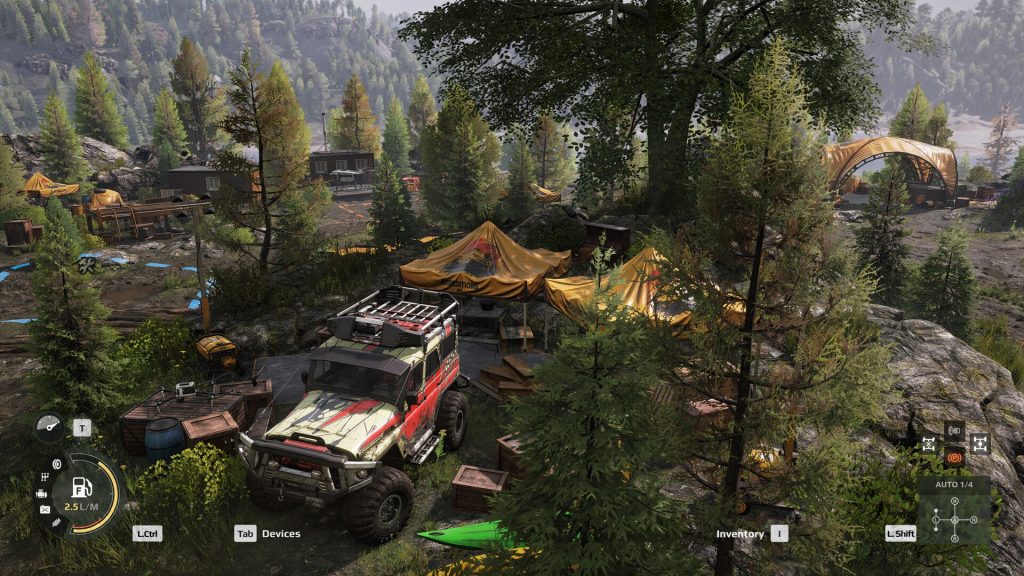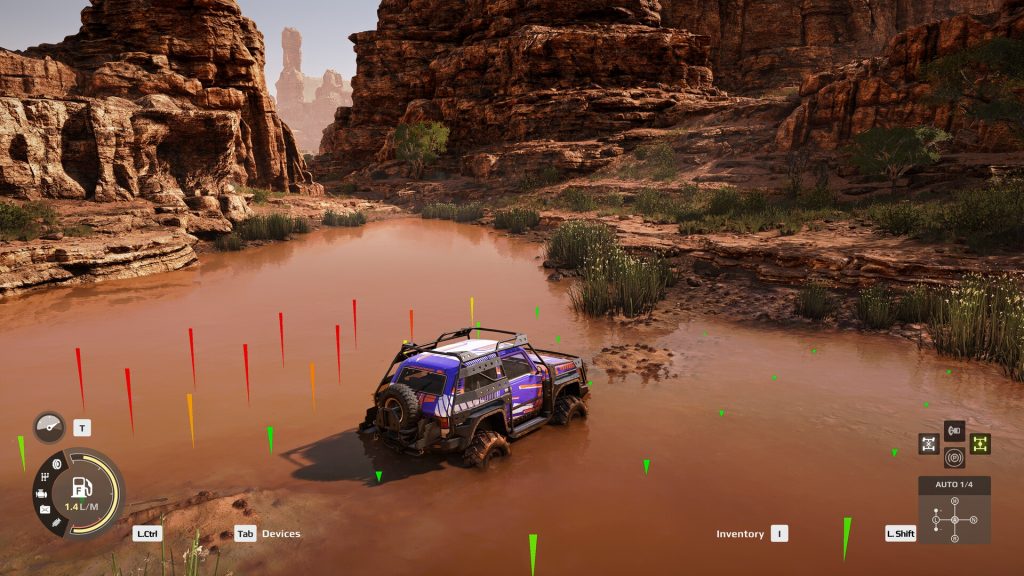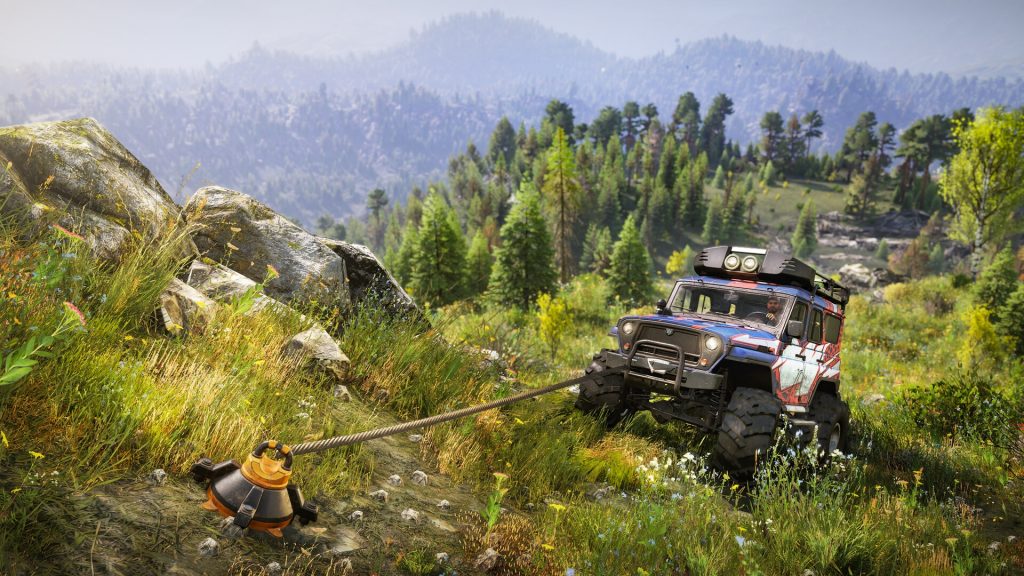
While most driving games out in the market these days largely revolve around the sport aspect of owning vehicles—namely racing—there exists a niche genre where you instead get behind the wheels and push the pedal to the metal and do things like deliver cargo; games like Euro Truck Simulator, and of course, MudRunner and SnowRunner. While there’s certainly an emphasis on trying to go fast in these games, rather than racing against other players, you’re instead racing against dwindling supplies and sometimes a time limit.
These games tap into an aspect of driving vehicles that not many other titles tend to use, namely the idea that the second-to-second gameplay of just driving a vehicle can be inherently interesting even without the feeling of competition. With Expeditions: A MudRunner Game, the developer has once more tapped into these aspects. What sets it apart from its predecessors, however, is that it also features a whole lot of everything else.
"Most missions you take on in Expeditions: A MudRunner Game will have you drive to a spot, maybe pick up some cargo, and transport it elsewhere."
To start with, Expeditions: A MudRunner Game is a title I like to refer to as a car-versus-environment game. There are barely any roads to drive on in the game, and most of the time, you’ll be trying to scale mountains and avoid falling off cliffs as you explore the world around you. Expeditions isn’t just meaningless exploration, however, as missions are a core part of how you’ll be spending your time with the game. The core gameplay revolves around completing various missions, earning money and unlocking upgrades for your vehicles in the process.
Most missions you take on in Expeditions: A MudRunner Game will have you drive to a spot, maybe pick up some cargo, and transport it elsewhere. Despite this being the main mission design in the entire game, what keeps things from getting stale is that the minute-to-minute driving in Expeditions never really gets boring.
Expeditions: A MudRunner Game leans heavily on the simulation side of off-road driving. Not only do you have to pay attention to regular things like rocks and cliffs, but you’ll also have to manage your car’s gear shifting, enable and disable your AWD and differential locks as needed, and even adjust your vehicle’s tyre pressure on the fly. Along with all of these options, you’ll also have to make sure you have enough spare parts to repair whatever damage you might take in the treacherous paths you decide to take, and even make sure that you’re carrying enough extra fuel to complete your mission.

"What keeps things from getting stale is that the minute-to-minute driving in Expeditions never really gets boring."
""
All of these smaller systems play quite well with each other. For example, leaving AWD on all the time is a terrible idea since, while your handling capabilities are greatly improved, your vehicle also starts guzzling down fuel at a faster pace. In longer missions, this could easily leave you stranded and need you to call in a vehicle extraction from your base, essentially erasing a whole bunch of progress in the process. Tyre pressure also similarly affects mileage. Thankfully, there are other tools to make life easier, with my personal favorite one being the winch. Essentially, the winch allows you to grapple on to a nearby tree and pull your vehicle through difficult terrains. The winch is also quite versatile, and you’ll eventually find yourself in missions where you’re tasked with retrieving entire vehicles by using the winch.
You’re never really going to drive at blazing speeds in Expeditions: A MudRunner Game, and considering the type of terrain you have to drive through, speed would be a terrible idea anyway. You’re instead rewarded for taking your time and plotting out your routes with several provided tools, which include a drone for some quick scouting, binoculars, and the echo sounder, which lets you figure out the depths of different nearby bodies of water. That’s right, going into water that’s too deep can also be incredibly dangerous, and not just because your car will disappear into its depths; you might just get stuck in a slightly deeper part of the river and be unable to drive your way out.
The biggest change in Expeditions from MudRunner and SnowRunner, along with its choice of maps, is the fact that there’s a much larger emphasis on building your own base up. As you complete missions, you’ll earn money, gather up supplies, and ultimately, be able to build up your base with different amenities that might end up making your life easier, be it fueling stations to make managing longer drives simpler, or the ability to swap out between your vehicles mid-mission.

"You’re rewarded for taking your time and plotting out your routes with several provided tools"
The main stars of Expeditions, however, are its maps. The game provides players with a host of different maps to explore, ranging from archeological sites and forgotten ruins all over Arizona, to the Grand Canyon, and even the Carpathians. The game can look downright gorgeous at times, and there’s definitely something special about spending several minutes trying to force your janky truck up the side of a particularly steep mountain, only to find a plateau, take a deep breath, and enjoy the beautiful scenery all around you. The fact that just about everything you see can also be explored—as long as you’re prepared and determined enough—is just icing on the cake.
It is worth noting that Expeditions relies a lot on a player’s own sense of purpose and drive to explore. There isn’t really much of an overarching story that’s sending you on an epic quest to deliver goods to these mountains. Unlike something like Death Stranding, you’re not going to meet characters that will debate each other about the nature of loneliness and isolation. The closest thing you’ll get to a narrative in Expeditions is in the descriptions for your missions, and even then, you won’t really get any real form of narrative aside from justifications for why you’re getting paid for driving in these remote locations.
Ultimately, none of that matters, however, since the core experience of driving in Expeditions is enough to carry the game on its own. The mechanical complexity achieved by the game by having several of its vehicle-management systems interact in interesting ways, all while you try to plot the least dangerous route through incredibly dangerous locations lends itself quite well for emergent narratives to form. You won’t really care about why you’re driving to a place and delivering some supplies. Rather, you’ll fondly remember all the trials and tribulations you faced while making the journey, and some of the smaller details, like how you almost ran out of fuel, or how you’re glad you had the foresight to bring a spare tyre for the trip.

"The mechanical complexity achieved by the game by having several of its vehicle-management systems interact in interesting ways"
""
Expeditions is far from a simple game. It is, however, quite an easy title to enjoy. The emergent narratives that pop up thanks to the game’s systems interacting in fun ways, along with your own sense of wanting to explore gorgeous cliffs and epic mountains, is what makes playing Expeditions: A MudRunner Game fun. The only real downside is that one of the best parts of MudRunner and SnowRunner—online co-op—won’t be making it into the game for a few more months after release. Aside from that, however, Expeditions: A MudRunner Game is still one of the more fun and interesting titles out there.
This game was reviewed on the PlayStation 5.
Driving is incredibly fun; Smaller details to manage interact in fun ways; The sheer scale of the maps; Gorgeous visuals
No co-op multiplayer at launch; Mistakes are punished severely.
















